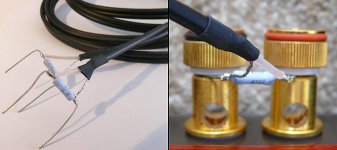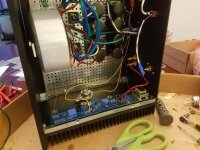I just finished an F4 build and would like to run it off my Elekit tu-8200 while I wait on parts to arrive for my BA3FE.
I read Nelson Pass’ instructions on hooking up an SET or low powered amplifier to run the F4 but wanted to clarify so I do not mess anything up.
Here is what I know:
Take RCA’s and cut off one end. Hook RCA cut end to the Elekit’s speaker outputs and the RCA non cut ends into the inputs of the F4. Is this correct?
Resistors are mentioned as an option, but what impedance and wattage across the terminals of the Elekit?
Thanks.
I read Nelson Pass’ instructions on hooking up an SET or low powered amplifier to run the F4 but wanted to clarify so I do not mess anything up.
Here is what I know:
Take RCA’s and cut off one end. Hook RCA cut end to the Elekit’s speaker outputs and the RCA non cut ends into the inputs of the F4. Is this correct?
Resistors are mentioned as an option, but what impedance and wattage across the terminals of the Elekit?
Thanks.
ideally , resistor at Elekit output needs to be of same impedance as speaker intended to be connected , so presume 8R
wattage - at least 3 times wattage of channel declared power
for little more swing and decreased THD , you can use double value resistor - say 16R
wattage - at least 3 times wattage of channel declared power
for little more swing and decreased THD , you can use double value resistor - say 16R
I know you don't need it, but in case someone else ends up using this thread as a reference, I found this picture from the 6moons article useful for building the cable (6moons audio reviews: FirstWatt F4).
Also, having personally built the Elekit, you'll know which speaker output is attached to ground and should be soldered to the RCA ground wire, but everyone using a commercial SET to drive the F4 should double check. As I was warned by Nelson, black does not always = ground.
Also, having personally built the Elekit, you'll know which speaker output is attached to ground and should be soldered to the RCA ground wire, but everyone using a commercial SET to drive the F4 should double check. As I was warned by Nelson, black does not always = ground.
Attachments
Awesome. Thank you both for the help. I will be trying the Elekit with F4 tonight and excited to see how it comes out.
I also have most of the parts to build another F4 within the next few months. Is it possible to run two F4 monoblocks with a small wattage amp as the front end?
I would think it would be the same concept accept adding a Y adapter to both RCA's from the small tube amp and wiring the F4 outputs in parallel... Correct me if I am wrong.
I also have most of the parts to build another F4 within the next few months. Is it possible to run two F4 monoblocks with a small wattage amp as the front end?
I would think it would be the same concept accept adding a Y adapter to both RCA's from the small tube amp and wiring the F4 outputs in parallel... Correct me if I am wrong.
Definitely. I actually built a switch (see attached image) so I could switch each F4 from stereo to monoblock operation. The switch just ties the inputs together so both channels get the same signal from a single RCA jack (I didn't like the idea of putting in a Y-adapter of questionable audio quality). I also built a switch to tie together the outputs, but Zen Mod convinced me that should only be done externally with speaker wires connecting the speaker binding posts.
In addition to the fully paralleled version, I also tried tying together the inputs but leaving the outputs separate to run a vertical bi-amp configuration. Here my bass units and head units (Coincident PRE's) each got their own 25W channel.
In the end, my speakers didn't really need the extra power and I went back to just having a single channel run each speaker.
I think there are a couple factors that made this superior. First, you get a single power supply for each channel (full dual mono power supplies) and this prevents one channel's activity from impacting power on the other. Second, because it's difficult to perfectly match the two channels, I think you get small timing and power differences that introduce a bit of smearing and make the system sound less coherent... not worth it if you don't actually need the power.
In addition to the fully paralleled version, I also tried tying together the inputs but leaving the outputs separate to run a vertical bi-amp configuration. Here my bass units and head units (Coincident PRE's) each got their own 25W channel.
In the end, my speakers didn't really need the extra power and I went back to just having a single channel run each speaker.
I think there are a couple factors that made this superior. First, you get a single power supply for each channel (full dual mono power supplies) and this prevents one channel's activity from impacting power on the other. Second, because it's difficult to perfectly match the two channels, I think you get small timing and power differences that introduce a bit of smearing and make the system sound less coherent... not worth it if you don't actually need the power.
Attachments
- Status
- Not open for further replies.
- Home
- Amplifiers
- Pass Labs
- How to incorporate F4 with Elekit Tu-8200


